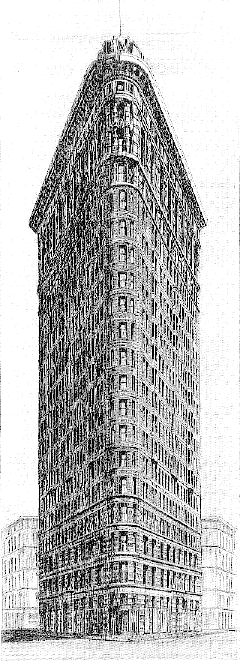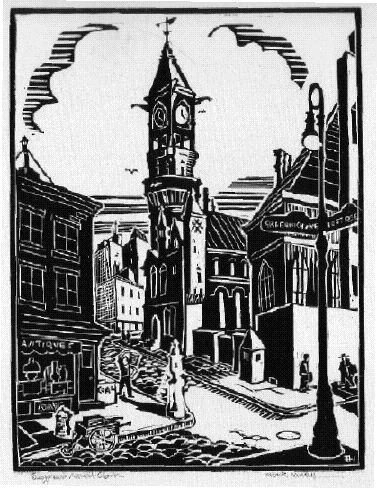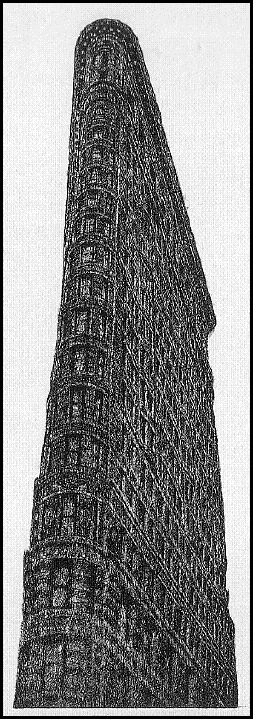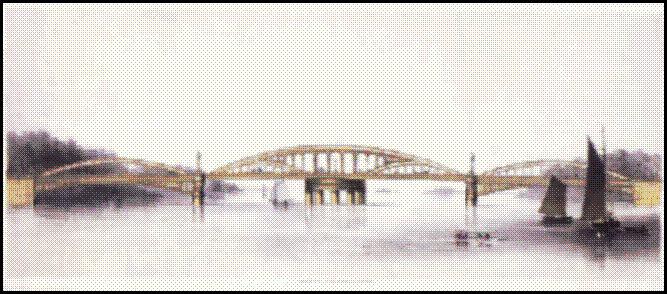Impressions of
New York
Prints from
The New-York
Historical Society
Marilyn Symmes
(Princeton Architectural Press)

Since its founding in 1804, the New-York Historical Society has collected some 175,000 prints of the city. At least, that's what they say here, but they might be exaggerating --- or outright lying. I figure that any organization that can't spell its own name (I didn't invent that hyphen; that's the way they write it) might fib a bit about how many lithographs and what-nots it owns. (I have the same problem when I'm reading some literary critic going on about Moby Dick. "It's Moby-Dick, dummy," I mutter, turning the page.)
Anyway, and any way you want to spell it, this historical society in an unnamed large city on the upper East Coast says they have thousands and thousands of "engravings, etchings, aquatints, drypoints, lithographs [and] woodcuts." They inveigled Princeton University Press to reproduce 165 of them in this volume, lovingly laid out --- 23 inches by 28 inches.
And not only is it classy, it's classic. The first engraving is a dream from around 1700 that shows, in the foreground, three contented Indians with bow, arrow, and lyre ... one embracing a palm tree (a palm tree grows in Brooklyn!) looking out at "N. Amsterdam, ou N. Iork in Ameriq:." It's in color, hand-tinted, as are many of the gorgeous lithographs in Impressions of New York. There are some of these pictures that are so pure you want to just hop right in and be there with, say, the bearded Sikhs, Buddhists and top-hatted gents in front of the "New-York Crystal Palace" 150 years ago. Or maybe we should apply for room-and-board at the "Home for the Friendless" (managed by the "American Female Guardian Society") on 29th Street, as represented in a hand-colored lithograph from 1853-1854, a fine, Jeffersonian-style building, cool and clean.
There are some of these pictures that are so pure you want to just hop right in and be there with, say, the bearded Sikhs, Buddhists and top-hatted gents in front of the "New-York Crystal Palace" 150 years ago. Or maybe we should apply for room-and-board at the "Home for the Friendless" (managed by the "American Female Guardian Society") on 29th Street, as represented in a hand-colored lithograph from 1853-1854, a fine, Jeffersonian-style building, cool and clean.
§ § § Did I mention that all these vistas --- at least the first eighty or so --- are highly romantic? From contemporary histories we learn that the greatest street problems of Victorian New York were not the horse-drawn vehicles and carts, nor the pimps, drunks and whores, but garbage, dog-shit, horse-shit, dead dogs, dead horses, and often dead people. People just got planted a foot or so below the sod in those days, and the churches and their graveyards were splendidly odoriferous with the aroma of the newly fallen.  No EPA in 1895. There was the omnipresent eye-smarting, nose-wrinkling, sneeze-inducing smoke of pitch fires, coal-fired manufacturing plants, soot from kerosene lamps, candles, and the stench of burning hemp. I just threw in that last to see if you were paying attention.
No EPA in 1895. There was the omnipresent eye-smarting, nose-wrinkling, sneeze-inducing smoke of pitch fires, coal-fired manufacturing plants, soot from kerosene lamps, candles, and the stench of burning hemp. I just threw in that last to see if you were paying attention.
Furthermore, unless you consider virgin streets a political statement, social commentary doesn't appear in Impressions of New York until print number 121. This is James Penney's funny, tilted subway scene, a riot of cross-bars and caps and hats. It's a lithograph that might have been done yesterday, except for the headgear and the absence of Poor People's Subway Art Shows, otherwise known as graffiti. This 1932 lithograph includes a drawing of a newspaper --- you're looking over a man's shoulder to read the headline --- "NOT MY BABY" SAYS ROOSEVELT. If you look to the opposite page for an explanation of this baffling cut from an ancient Daily Mirror, all you find are the let's-fill-a-page scribblings of Ms. Symmes,
Numerous American artists have made the subway the subject of their art. Every ride presents a fascinating opportunity to study individual gestures and styles of dress, as well as the different economic, cultural, and racial microcosms within the city.
That's it for FDR's alleged bastard child.
Towards the end there are two or three woodcuts/linocuts of the World Trade Center, before and after. Again, romance plays heavily in this. The twin towers were a travesty, shoehorned into existence by the New York Port Authority and Nelson Rockefeller with the compliance of an indifferent city administration and a superbly mediocre architect. The great pity is that this oh-too-brutish structure has now been transformed into a symbol of those murdered in a religious war that never should have been. It's the famous double bind: We are cheered that the two vulgar pillars are gone forever, only to be saddened that it had to happen in such a damnable way, for such a diabolical cause.

 There are some of these pictures that are so pure you want to just hop right in and be there with, say, the bearded Sikhs, Buddhists and top-hatted gents in front of the "New-York Crystal Palace" 150 years ago. Or maybe we should apply for room-and-board at the "Home for the Friendless" (managed by the "American Female Guardian Society") on 29th Street, as represented in a hand-colored lithograph from 1853-1854, a fine, Jeffersonian-style building, cool and clean.
There are some of these pictures that are so pure you want to just hop right in and be there with, say, the bearded Sikhs, Buddhists and top-hatted gents in front of the "New-York Crystal Palace" 150 years ago. Or maybe we should apply for room-and-board at the "Home for the Friendless" (managed by the "American Female Guardian Society") on 29th Street, as represented in a hand-colored lithograph from 1853-1854, a fine, Jeffersonian-style building, cool and clean. No EPA in 1895. There was the omnipresent eye-smarting, nose-wrinkling, sneeze-inducing smoke of pitch fires, coal-fired manufacturing plants, soot from kerosene lamps, candles, and the stench of burning hemp. I just threw in that last to see if you were paying attention.
No EPA in 1895. There was the omnipresent eye-smarting, nose-wrinkling, sneeze-inducing smoke of pitch fires, coal-fired manufacturing plants, soot from kerosene lamps, candles, and the stench of burning hemp. I just threw in that last to see if you were paying attention. 